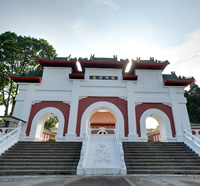The Chinese Garden, otherwise known as Yu Hwa Yuan, spans 13.5 hectares. It was built from an area once occupied by fish and prawn ponds fronting the banks of the 6 mile long Jurong River.
The garden was developed as part of a comprehensive development plan for the Jurong Industrial Estate by Jurong Town Corporation (JTC) which sought to attract visitors to Jurong while retaining nature within the predominantly industrial area.
Under the abovementioned plan, Jurong River was converted into a lake with three islands, with the Chinese Garden covering one of them. It was the largest Chinese Garden outside of China and served as a contrast with the “dry” Japanese Garden.
Construction works for the Chinese Garden began in 1971 and the garden was completed in April 1975 at the cost of S$5 million. During its opening weekend, the garden attracted 21,000 visitors and by 1976, 1,624,316 visitors had visited the garden.
The Chinese Garden is the only typical Chinese traditional park in Southeast Asia and it is modelled on the Beijing Summer Palace as well as on the picturesque gardens of the Song Dynasty and Suzhou Gardens.
Some of the garden’s distinguishing features include the main Gate House with its bright red doors, the white rainbow bridge which leads from the Gate House to the main arch entrance, the 48-metres high-seven storey Cloud Piercing Pagoda, the Stone Boat, and the five pavilions.
In 1985, a 10 metre high bronze statue of Confucius (the Chinese philosopher) was erected near the lotus pond by the Singapore Nanyang Confucius Association, and in 1989, the Bridge of Double Beauty was constructed to link the Chinese and Japanese Gardens.
A new Bonsai Garden was also built in 1992 at the estimated cost of S$3.8 million and involved 55 Suzhou craftsmen from China. The garden features a main hall and houses a collection of over 2,000 pots of bonsai imported from China and other parts of the world.
In the 1990s, a new east entrance to the garden via a new arched bridge and entrance plaza from the Chinese Garden MRT station was built and the red arched bridge itself symbolises good luck.
Throughout the 2000s, new attractions were added to the Chinese Garden and these include the Live Turtle and Tortoise Museum (2002), the Garden of Abundance (2002) which features pomegranate trees and sculptures of zodiac animals and the Eight Legendary Chinese Heroes (2007) statues which were relocated from Marina’s City Park Sculpture Garden.
From the 1970s, mid-autumn festivals were celebrated at the Chinese Garden and during these annual festivals, hundreds of lanterns decorated the garden. Each year, the celebrations had a different theme, and from 1987 onwards, they attracted over 100,000 visitors to celebrate the Mid-autumn festival.
In 1999, the garden organised its biggest mid-autumn festival and displayed over 2,000 lanterns from China’s Guangdong province. The highlight of the festival was a 10 metre long Dragon and Phoenix Pillar Millenium Lantern.
From 1982, Chinese New Year celebrations were also held in the Chinese Garden and other notable events held in the garden included the 1985 Chrysanthemum and Bonsai Show. In more recent years, the Chinese Garden played host to events such as the 2003 Summer Festival and the 2007 Sports-a-thon organised by the Jurong Group Representative Constituency.
A project by National Heritage Board.







